Vortex Induced Vibrations
Vortex Induced Vibrations (VIV) are a source of both fascination and challenge to engineers. Here is an overview of the phenomenon.
Our goal is to answer the questions:
What are Vortex Induced Vibrations?
How do you predict Vortex Induced Vibration?
How do you avoid or at least reduce Vortex Induced Vibrations?
Vortex Shedding
Whenever you drag a cylinder through a liquid or gas, vortices are created in the wake. The vortices tend to form a zig-zag pattern, as you can see in the video clip from Lausts kitchen.
The pattern is extremely general. It happens at very small scale (the wind making a wind harp sound) up to the largest scales we can observe, see the wind around an island in the video below. And the cylinder can be long, short, round or otherwise, even a finger will do. This is a phenomenon that happens everywhere.
We call it vortex shedding, and the zig zag pattern a von Kàrmàn Vortex Street. Physicists and engineers have wondered about it for a long time.
Come to think of it, these vortices are also what makes the “swoosh” sound when you swing a bamboo stick quickly through the air.
Vortex shedding in various satellite imagery.
Credit: NOAA, NASA Goddard Space, Flight Center CIRA
The flow is radically different around the wind harp string and the island, in one case laminar and in the other extremely turbulent – but the vortex shedding occurs nevertheless, and the zig zag pattern is pretty much the same.
Normally we can’t see vortex shedding happening, but here is a trick. Next time you pass a flag waving in the wind, take a moment to look at it. Sometimes, especially if the flag is narrow and the wind is strong, you see little regular waves radiating downwind from the pole – That’s vortex shedding from the flagpole!

The effect of vibrations
So why are engineers so interested in these vortices? Well, there are many man-made cylinders standing around in the wind.
Just think of a steel smokestack or chimney. Vortex shedding will be happening there all the time. And each time the wind changes, the smokestack gets a little push.
The forces are tiny, but because they are rhythmic, funny things can happen. And that’s what we call Vortex Induced Vibration (or VIV).
If the rythm is just right, every little push makes the smokestack move a little more. The “right rythm” means that the wind blows at a particular speed, which fits perfectly with the particular structure.
Sometimes, things start to move, see this video. A tower that’s been standing still for months can suddenly begin shaking violently, when that very particular wind occurs.
Engineers worry about these vibrations because they put people in danger. And the repeated bending can fatigue the material or break the tower, so the ground below is not really safe either.
When the vibrations start, you basically just have to hold on tight and hope for the best until the wind changes. So engineers need to be able to predict when vibrations can happen and take countermeasures before someone get’s hurt.
Steel stack vibrating in St. Dennis, Cornwall, UK.
So how about the numbers?
In this section we touch on the quantitative methods used by engineers to predict when VIV occurs and to describe the actions that can be taken against VIV.
Especially, we need to learn about two numbers that tell us if VIV is a problem: The critical wind speed $U_c$ and the Scruton number $\mathrm{Sc}$.
As we mentioned above, VIV happens when the rythm (frequency) of the vortices matches the motion of the structure. This matching of rhythms is called resonance.
The rythm is determined by three numbers: The wind speed $U$, the cylinder diameter $D$ and the so-called Strouhal number $\mathrm{St}$. When the wind speed is equal to a critical wind speed $U_c$, the vortex rythm matches the movement of the structure, which tends to vibrate at its eigenfrequency $f$. We can calculate $U_c$ by this formula
$U_c=\frac{D \cdot f}{\mathrm{St}}$
The Strouhal number measures the geometry of the vortex wake, as you can see in the figure below. It depends on the shape of the structure, the Reynolds number (*) and the amount of turbulence in the air. The engineer usually looks it up in a table. For a circular cylinder, $\mathrm{St}\approx 0.2$.

So VIV occurs when the wind speed is close to $U_c$. And once you know your critical wind speed $U_c$, you have an idea of whether you need to worry about vortex shedding.
Example 1:Small wind turbine tower
The second mode eigenfrequency of $f=4 \mathrm{Hz}$. The relevant tower diameter (near the middle) is $D=2.5 \mathrm{m}$ and, so $U_c\approx 50 \mathrm{m/s}$. Those kinds of wind almost never occur, suggesting that you do not need to worry that much about VIV for this tower vibration mode.
Example 2: Modern tall wind turbine tower
The mode 2 eigenfrequency is $f=1 \mathrm{Hz}$, and $D=4 \mathrm{m}$, so $U_c\approx 20 \mathrm{m/s}$. Such wind speeds do occur regularly, so VIV is a risk.
The mass-damping parameter (Scruton number)
We’ve established that structures can experience VIV for wind speeds close to $U_c$ .
But we’re short of an answer to why some structures suffer from VIV while others don’t. It turns out to depend on two properties: the damping of the structure and how heavy the structure is relative to the air. Not surprisingly, strongly damped structures vibrate less than lightly damped structures. Furthermore, heavy structures vibrate less than light structures.
So you won’t see stone lighthouses suffering from VIV. Modern structures are optimized to be cheap and light, so they are basically built for VIV!
Quantitatively, physicists and engineers have determined that the amount of vibration depends on a single number, the mass-damping parameter, also called the Scruton number $\mathrm{Sc}$:
$\mathrm{Sc}=\frac{2\cdot \delta\cdot m}{\rho\cdot D^2}$
Here $\delta$ is the damping and $\frac{m}{\rho \cdot D^2}$ is the mass of the cylinder compared to the mass of the displaced air ($\rho$ is the air density, and $D$ is the cylinder diameter).
For large Scruton numbers (heavy and/or highly damped structures), $\mathrm{Sc}\gtrapprox 15$, the vibrations are small. Also, the motions are irregular, with periods of relative calm, interrupted by the occasional burst of a few slightly larger oscillations.
For small Scruton numbers (light and/or lightly damped structures – the typical case for modern steel structures), $\mathrm{Sc}\lessapprox 5$, the vibrations can become very large. Also, the vibrations tend to be rythmic and regular and can persist uniterrupted for long periods of time.
Note that things become even more complicated for certain geometries and when multiple cylinders are present. For example, cylinders with a square cross-section can experience extremely strong VIV. Likewise, large amplitude VIV effects can occur in the presence of multiple bodies (phenomena known as group effects or wake galloping).
The relationship between Scruton number and vibration amplitude is indicated in the sketch below. Note that the peak amplitude is determined by multiplying the characteristic amplitude by the so-called peak factor, which is close to $\sqrt{2}$ for low Scruton numbers and close to $4$ for high Scruton numbers.
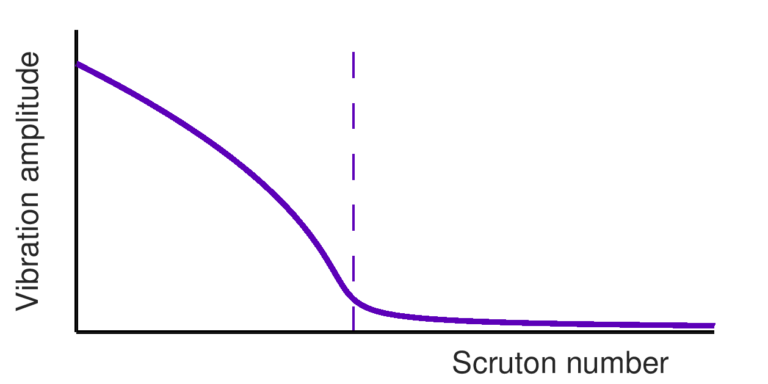
Such a diagram is sometimes referred to as a Scruton curve or a Griffin plot.
How can we avoid VIV?
We need to be able to predict when VIV can occur, and to design structures that are not vulnerable to it.
When designing any light structure (for example a steel smokestack, a tall tower, a wind turbine or a suspension bridge), it is necessary to verify beforehand that VIV does not damage the structure or put people in danger.
Building codes such as the Eurocode EN1991-1-4 (method 2) specify criteria for acceptable high values of the critical wind speed and the Scruton number. These criteria are usually sufficient to avoid VIV problems, but the resulting designs may heavier and more expensive than what is necessary.
So the building code guidelines may be impractical in some situations, and in other cases they are difficult to apply or some for certain situations. In particular, the building codes fall short of fully predicting safe design involving complicated geometries or the presence of multiple cylinders.
In these cases, expert advice may allow for better designs and lower overall project costs.
There are basically three options to avoid VIV:
- Increase the Scruton number by adding damping or by making the structure heavier.
- Increase the stiffness of the structure so as to increase the critical wind speed of the range of commonly occuring winds.
- Change the aerodynamic loads on the structure by surface/shape modifications.
A couple of notes about these options:
Option 2 often requires very large shifts in the structure eigenfrequency, which would lead to prohibitively high costs.
Option 3 can include helical strakes, see the figure below.
Helical strakes are often used on steel smokestacks, and they can in some cases mitigate VIV problems. They do not always work, though, as shown here.
Strakes need to be of significant height, approximately 10% of $D$, and they work best, when the damping is sufficiently high (and so also $\mathrm{Sc}$).
A further downside to strakes is that they increase the effective cross section of the structure, and so both the static wind load and the buffeting forces from gusts are increased by up to about 20%.
For more discussions about possible mitigation strategies, see this case.

Smokestack TMDs are sometimes hidden inside the cylindrical stack, typical for large diameter multi-pipe stacks. Here, the TMD is in the annular chamber near the stack top.
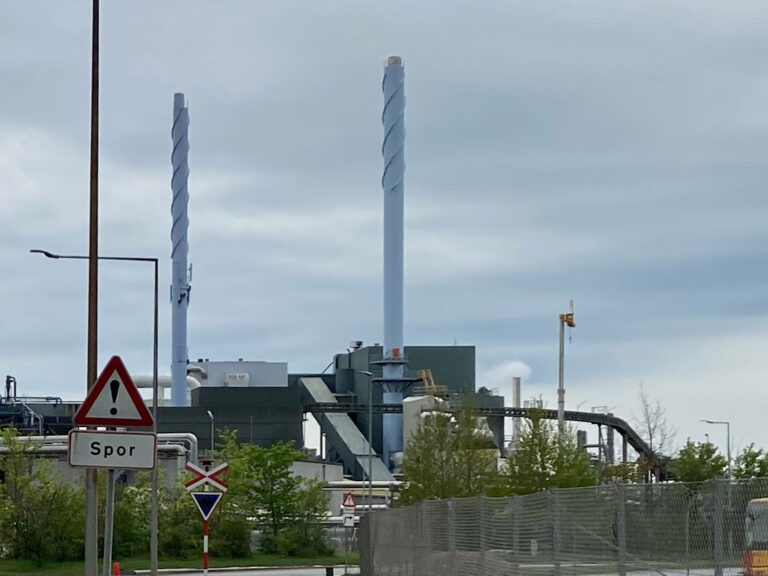
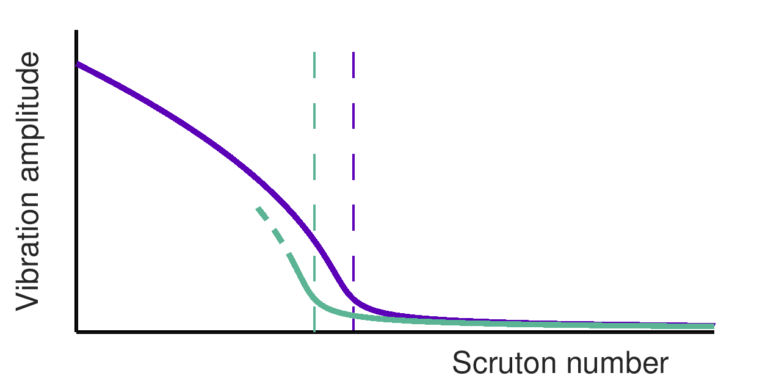
The green curve indicates the characteristic amplitude for a tower fitted with large strakes - leading to a slightly smaller critical Scruton number.
See also the work by [Ruscheweyh, J. Wind Eng. & Ind. Aerodyn. 8 (1981) 203-210] and Sumer & Fredsøe (1997) Hydrodynamics around Cylindrical Structures, World Scientific, Singapore.
Summary
VIV is a source of risk and uncertainty for many engineering projects, including wind energy and industry. Safe practices are available to ensure designs that are safe from VIV, but expert advice is needed in many cases.
We have treated a specific example case of VIV risks and a possible mitigation action in more detail here.
In most cases, the simplest and most reliable countermeasure against VIV is to increase the system damping, e.g. by installing a Tuned Mass Damper (TMD).
Share

Check out this small video of me pulling my finger through a thin layer of milk and food colouring in my kitchen.


